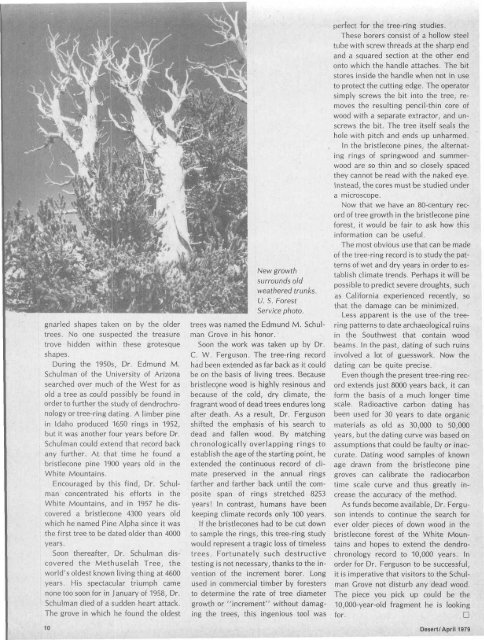Come - Desert Magazine of the Southwest
Come - Desert Magazine of the Southwest
Come - Desert Magazine of the Southwest
You also want an ePaper? Increase the reach of your titles
YUMPU automatically turns print PDFs into web optimized ePapers that Google loves.
gnarled shapes taken on by <strong>the</strong> older<br />
trees. No one suspected <strong>the</strong> treasure<br />
trove hidden within <strong>the</strong>se grotesque<br />
shapes.<br />
During <strong>the</strong> 1950s, Dr. Edmund M.<br />
Schulman <strong>of</strong> <strong>the</strong> University <strong>of</strong> Arizona<br />
searched over much <strong>of</strong> <strong>the</strong> West for as<br />
old a tree as could possibly be found in<br />
order to fur<strong>the</strong>r <strong>the</strong> study <strong>of</strong> dendrochronology<br />
or tree-ring dating. A limber pine<br />
in Idaho produced 1650 rings in 1952,<br />
but it was ano<strong>the</strong>r four years before Dr.<br />
Schulman could extend that record back<br />
any fur<strong>the</strong>r. At that time he found a<br />
bristlecone pine 1900 years old in <strong>the</strong><br />
White Mountains.<br />
Encouraged by this find, Dr. Schulman<br />
concentrated his efforts in <strong>the</strong><br />
White Mountains, and in 1957 he discovered<br />
a bristlecone 4300 years old<br />
which he named Pine Alpha since it was<br />
<strong>the</strong> first tree to be dated older than 4000<br />
years.<br />
Soon <strong>the</strong>reafter, Dr. Schulman discovered<br />
<strong>the</strong> Methuselah Tree, <strong>the</strong><br />
world's oldest known living thing at 4600<br />
years. His spectacular triumph came<br />
none too soon for in J anuary <strong>of</strong> 1958, Dr.<br />
Schulman died <strong>of</strong> a sudden heart attack.<br />
The grove in which he found <strong>the</strong> oldest<br />
New growth<br />
surrounds old<br />
wea<strong>the</strong>red trunks.<br />
U. S. Forest<br />
Service photo.<br />
trees was named <strong>the</strong> Edmund M. Schulman<br />
Grove in his honor.<br />
Soon <strong>the</strong> work was taken up by Dr.<br />
C. W. Ferguson. The tree-ring record<br />
had been extended as far back as it could<br />
be on <strong>the</strong> basis <strong>of</strong> living trees. Because<br />
bristlecone wood is highly resinous and<br />
because <strong>of</strong> <strong>the</strong> cold, dry climate, <strong>the</strong><br />
fragrant wood <strong>of</strong> dead trees endures long<br />
after death. As a result, Dr. Ferguson<br />
shifted <strong>the</strong> emphasis <strong>of</strong> his search to<br />
dead and fallen wood. By matching<br />
chronologically overlapping rings to<br />
establish <strong>the</strong> age <strong>of</strong> <strong>the</strong> starting point, he<br />
extended <strong>the</strong> continuous record <strong>of</strong> climate<br />
preserved in <strong>the</strong> annual rings<br />
far<strong>the</strong>r and far<strong>the</strong>r back until <strong>the</strong> composite<br />
span <strong>of</strong> rings stretched 8253<br />
years! In contrast, humans have been<br />
keeping climate records only 100 years.<br />
If <strong>the</strong> bristlecones had to be cut down<br />
to sample <strong>the</strong> rings, this tree-ring study<br />
would represent a tragic loss <strong>of</strong> timeless<br />
trees. Fortunately such destructive<br />
testing is not necessary, thanks to <strong>the</strong> invention<br />
<strong>of</strong> <strong>the</strong> increment borer. Long<br />
used in commercial timber by foresters<br />
to determine <strong>the</strong> rate <strong>of</strong> tree diameter<br />
growth or "increment" without damaging<br />
<strong>the</strong> trees, this ingenious tool was<br />
perfect for <strong>the</strong> tree-ring studies.<br />
These borers consist <strong>of</strong> a hollow steel<br />
tube with screw threads at <strong>the</strong> sharp end<br />
and a squared section at <strong>the</strong> o<strong>the</strong>r end<br />
onto which <strong>the</strong> handle attaches. The bit<br />
stores inside <strong>the</strong> handle when not in use<br />
to protect <strong>the</strong> cutting edge. The operator<br />
simply screws <strong>the</strong> bit into <strong>the</strong> tree, removes<br />
<strong>the</strong> resulting pencil-thin core <strong>of</strong><br />
wood with a separate extractor, and unscrews<br />
<strong>the</strong> bit. The tree itself seals <strong>the</strong><br />
hole with pitch and ends up unharmed.<br />
In <strong>the</strong> bristlecone pines, <strong>the</strong> alternating<br />
rings <strong>of</strong> springwood and summerwood<br />
are so thin and so closely spaced<br />
<strong>the</strong>y cannot be read with <strong>the</strong> naked eye.<br />
Instead, <strong>the</strong> cores must be studied under<br />
a microscope.<br />
Now that we have an 80-century record<br />
<strong>of</strong> tree growth in <strong>the</strong> bristlecone pine<br />
forest, it would be fair to ask how this<br />
information can be useful.<br />
The most obvious use that can be made<br />
<strong>of</strong> <strong>the</strong> tree-ring record is to study <strong>the</strong> patterns<br />
<strong>of</strong> wet and dry years in order to establish<br />
climate trends. Perhaps it will be<br />
possible to predict severe droughts, such<br />
as California experienced recently, so<br />
that <strong>the</strong> damage can be minimized.<br />
Less apparent is <strong>the</strong> use <strong>of</strong> <strong>the</strong> treering<br />
patterns to date archaeological ruins<br />
in <strong>the</strong> <strong>Southwest</strong> that contain wood<br />
beams. In <strong>the</strong> past, dating <strong>of</strong> such ruins<br />
involved a lot <strong>of</strong> guesswork. Now <strong>the</strong><br />
dating can be quite precise.<br />
Even though <strong>the</strong> present tree-ring record<br />
extends just 8000 years back, it can<br />
form <strong>the</strong> basis <strong>of</strong> a much longer time<br />
scale. Radioactive carbon dating has<br />
been used for 30 years to date organic<br />
materials as old as 30,000 to 50,000<br />
years, but <strong>the</strong> dating curve was based on<br />
assumptions that could be faulty or inaccurate.<br />
Dating wood samples <strong>of</strong> known<br />
age drawn from <strong>the</strong> bristlecone pine<br />
groves can calibrate <strong>the</strong> radiocarbon<br />
time scale curve and thus greatly increase<br />
<strong>the</strong> accuracy <strong>of</strong> <strong>the</strong> method.<br />
As funds become available, Dr. Ferguson<br />
intends to continue <strong>the</strong> search for<br />
ever older pieces <strong>of</strong> down wood in <strong>the</strong><br />
bristlecone forest <strong>of</strong> <strong>the</strong> White Mountains<br />
and hopes to extend <strong>the</strong> dendrochronology<br />
record to 10,000 years. In<br />
order for Dr. Ferguson to be successful,<br />
it is imperative that visitors to <strong>the</strong> Schulman<br />
Grove not disturb any dead wood.<br />
The piece you pick up could be <strong>the</strong><br />
10,000-year-old fragment he is looking<br />
for. •<br />
10 <strong>Desert</strong>/April 1979
















